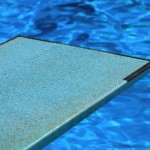It’s no secret that swimmers nowadays want more from their community pools. Run-of-the-mill competition pools no longer suffice.
Interactive features are a must-have at any aquatic facility. Though pools will never be full-fledged waterparks, it doesn’t mean that they can’t feature some of the same fixtures. There are many options that pool operators can choose from, including waterslides, spray nozzles, climbing walls and much more. Installing these features is a big step, so you may be considering something smaller, like a diving board. However, there are a couple of considerations to make before installing one.
Prepare accordingly
If you’re curious as to why you haven’t seen many diving boards in the past several years, there’s a simple reason for it: safety. Unless people know how to approach and jump off of one, there are many chances for accidents. The slippery surface can lead to falls, which can then result in cuts and bruises. Here are two things to keep in mind if you’re considering a diving board.
1. Ensure pool compliance: Some regulatory bodies consider diving boards so dangerous that they’re downright not allowed. Therefore, it’s important to check with local and federal rules prior to installation. Otherwise, not only will you have to remove the board, but you might also be fined for having it.
2. Work with a pool company: Once you’re sure that it’s legal to install a diving board at your facility, work with pool construction experts from a full-service pool company. These specialists will know the ins and outs of safety and pool compliance. They’ll advise you on diving board dimensions and additional precautions that you can take to heighten safety, such as padding the pool deck under the board to minimize the likelihood of injuries if people fall off before they reach the water. Installing a diving board will affect your overall operations, and if you’ve never managed a facility with one, figuring out the details can be challenging. A full-service pool company gives you access to experts in management and maintenance as well, which can be valuable resources.
Additionally, you’ll need to reassess lifeguard routines because the diving board is sure to be a hit among swimmers. During the first few days, when the lifeguard is getting used to the change in traffic, it may be wise to staff another lifeguard-certified employee poolside to help keep an eye on the pool. Once lifeguards adapt to the changes, you can return to having one lifeguard.





